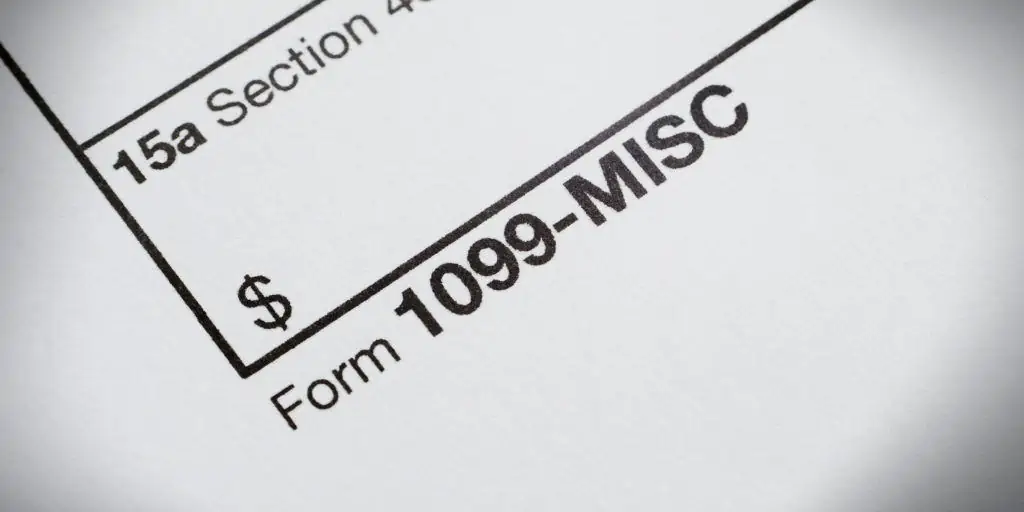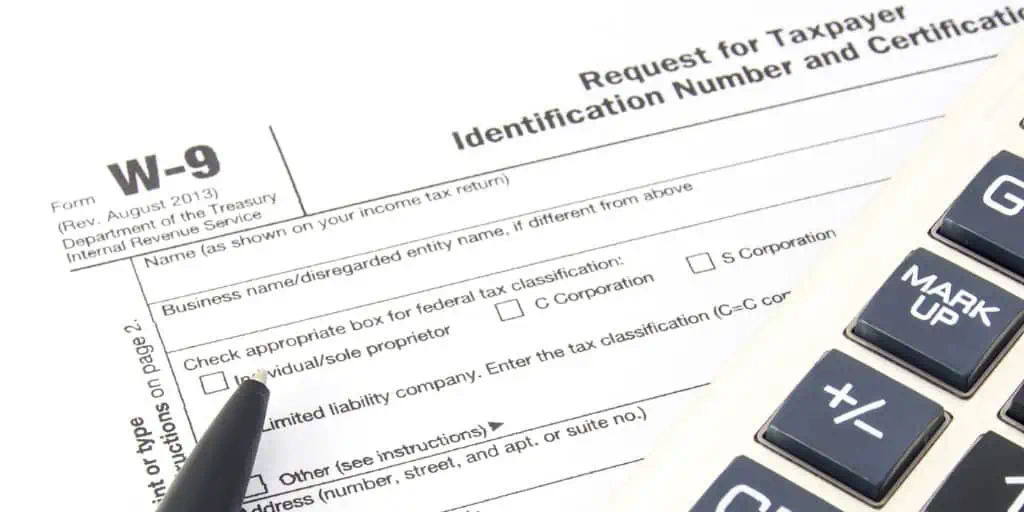What Is a W-9 Form?
REtipster does not provide tax, investment, or financial advice. Always seek the help of a licensed financial professional before taking action.
What Is the W-9 Form Used For?
Certain types of workers, such as independent contractors, freelancers, or gig workers, use the IRS Form W-9 (or simply W-9) to provide their taxpayer identification number[1] and other information to a company, entity, or individual that pays them for their services.
A W-9 Form is similar to a W-4 Form, which is used instead by workers employed by the entity.
Generally, the W-9 form helps track the income taxes for certain earnings that IRS backup withholding does not cover[2].
One of the most important parts of a W-9 is the taxpayer identification number (TIN). Note that when a taxpayer fills out a W-9 as a self-employed individual, their social security number[3] is usually their TIN. When filing for their business, it is their employer identification number (EIN).
Besides the TIN, the information in the W-9 form includes[4]:
- Taxpayer’s full legal name.
- Business name if the taxpayer is operating as a business.
- Business entity if the taxpayer is run as a C corporation, limited liability company (LLC), or partnership.
- Exemptions, if applicable.
- Address.
- Signature.
Submitting a W-9 allows the paying entity to prepare a Form 1099[5] for the independent contractor. Form 1099 is a collection of tax reports that detail income paid from an entity that is not the taxpayer’s full-time employer.
A paying entity (the organization that pays for an independent contractor’s services) accomplishes the correct Form 1099 from the provided information filled out in a W-9 by the independent contractor.
After opting to hire independent contractors, the paying entity should accomplish the correct type of Form 1099 for the individual, company, or self-employed vendor that they are reporting to the IRS. For example, an independent contractor is usually reported on Form 1099-NEC (non-employee compensation). This form allows the payer to report their independent contractor’s income if it exceeds $600 in a calendar year[6].
There are other types of Form 1099s, one of which is 1099-MISC for rental income.
Who Are Required to File W-9s?
Anyone with independent contractor status, including freelancers, vendors, and other similar entities that are not employed full-time by an entity, should fill out a W-9 form[7].
The W-9 form also furnishes information on other types of income not necessarily related to being self-employed. The other types of income that need the submission of a W-9 form include[8]:
- Acquisition or abandonment of secured property.
- Debt cancelation.
- Contributions to an individual retirement account.
- Dividends.
- Miscellaneous income.
- Mortgage interest a taxpayer pays.
- Real estate transactions.
- Sales of stocks and mutual funds.
- Broker transactions.
W-9 Requirement Threshold
In general, payments of more than $600 per calendar year require the submission of a W-9 form to the payer. This submission requirement also applies to direct sales of over $5,000.
In continuous business relationships, it is common for independent contractors to cross this threshold within a year[9].
Independent contractors are expected to pay taxes on all earned income, even if the net income from a contract is under $600. While the hiring company does not need to fulfill a 1099 for payments under $600 in a tax year, tax law stipulates independent contractors should always report payments.
Many self-employed workers choose not to report income below $600, though the internal revenue service still requires those earnings to be included on an income tax return.
Banks or other financial institutions may also ask investors to complete a W-9 for incomes due to dividends and interest.
Complying with the W-9 submission requirement is advisable even for payments below the thresholds. Doing so ensures 100% compliance with IRS regulations.
BY THE NUMBERS: About $5.4 trillion in income and payroll taxes are collected in the U.S. annually.
Source: usgovernmentrevenue.com
Backup Withholding Tax and W-9
Backup withholding happens when the IRS taxes income that is not typically subject to tax, such as income reported on a Form 1099.
This tax is called backup withholding tax, which is fixed at 24%.
This usually occurs due to several reasons, such as:
- The taxpayer did not supply their TIN.
- The taxpayer has refused to provide their TIN on a W-9 or a W-4.
- The taxpayer has a history of underreporting taxes
- The taxpayer has failed to declare that they are not subject to a backup withholding tax.
If the IRS receives unclear or insufficient information on a Form 1099 from the paying entity, the IRS may perform backup withholding to ensure that they collect the amount owed to them.
Taxpayers can prevent backup withholding by providing the correct taxpayer identification number and paying their taxes accordingly. For those who were subject to backup withholding, it can be reported as income taxes withheld on their income tax statement.
The backup withholding setup for independent contractors non-compliant with W-9 is similar to the tax reporting arrangement for regular employees. Instead of a W-9, the regular employees of a company fill out the W-4 form.
Penalties on W-9 Non-Filing or Errors
Theoretically, employers can get their independent contractors’ TIN by other means besides the W-9 form. However, it carries less risk and reduces liability for employers to ask their independent contractors to submit a W-9.
Employers face civil and criminal penalties if they misuse or improperly disclose a TIN or social security number provided on an independent contractor’s W-9. On the other hand, incorrect information on a W-9 form makes the independent contractors who filed it liable, not the employers[10].
An independent contractor or self-employed vendor who refuses to submit an employer’s request for a W-9 is subject to a $50 fine for each refusal.
Requesting a W-9 from a contractor should be recorded, as per IRS guidelines. The hiring party can request up to three times. If the contractor still does not comply after the third attempt, the employer may file Form 1099 with or without their independent contractor’s taxpaying information, upon which the contractor will be subject to backup withholding.
Takeaways
- A W-9 Form is a tax reporting form that requests taxpaying information of either an independent contractor or self-employed vendor.
- Payers (who enlist the services of independent contractors) use the information in a W-9 to accomplish a Form 1099, which is sent to the IRS.
- Incomplete or unclear information on a Form 1099 may subject the payer—and by extension the contractor—to backup withholding tax, which is a flat 24% rate, on an income otherwise not subject to tax.
Sources
- Internal Revenue Service. (n.d.) About Form W-9, Request for Taxpayer Identification Number and Certification. Retrieved from https://www.irs.gov/forms-pubs/about-form-w-9
- Motley Fool. (2017.) How to Calculate Tax on W-9 Income. Retrieved from https://www.fool.com/knowledge-center/how-to-calculate-tax-on-w-9-income.aspx
- Internal Revenue Service. (n.d.) Form W-9 Request for Taxpayer Identification Number and Certification. Retrieved from https://www.irs.gov/pub/irs-pdf/fw9.pdf
- Indeed. (2021.) W-4 vs. W-9: What’s the Difference? (With FAQs). Retrieved from https://www.indeed.com/career-advice/career-development/w4-vs-w9
- Freedman, M. (2022.) W-9 vs. 1099: What’s the Difference? Business News Daily. Retrieved from https://www.businessnewsdaily.com/15783-w9-1099-tax-forms.html
- Tuovila, A. (2022.) Form 1099-NEC: Nonemployee Compensation. Investopedia. Retrieved from https://www.investopedia.com/form-1099-nec-nonemployee-compensation-definition
- UpCounsel. (n.d.) Who Should Fill Out a W 9? Everything You Need to Know. Retrieved from https://www.upcounsel.com/who-should-fill-out-a-w-9
- H & R Block. (n.d.) What Is a W-9 Tax Form? Retrieved from https://www.hrblock.com/tax-center/irs/forms/w-9-tax-form/
- Rosenberg, E. (2022.) When Does Your Business Need a W-9 for Payments? Entrepreneur. Retrieved from https://due.com/blog/w-9-for-payments/
- Adams, R. (2022.) Form W-9 – What Is It and How Is It Used? TurboTax | Intuit. Retrieved from https://turbotax.intuit.com/tax-tips/self-employment-taxes/what-is-the-purpose-of-an-irs-w-9-form/L0ZtUOnSk
- Basis 365. (2019.) What Consequences Does Not Collecting a W-9 from Vendors Have? Retrieved from https://www.basis365.com/blog/risk-exposure-and-penalties-for-not-collecting-form-w-9-from-vendors







